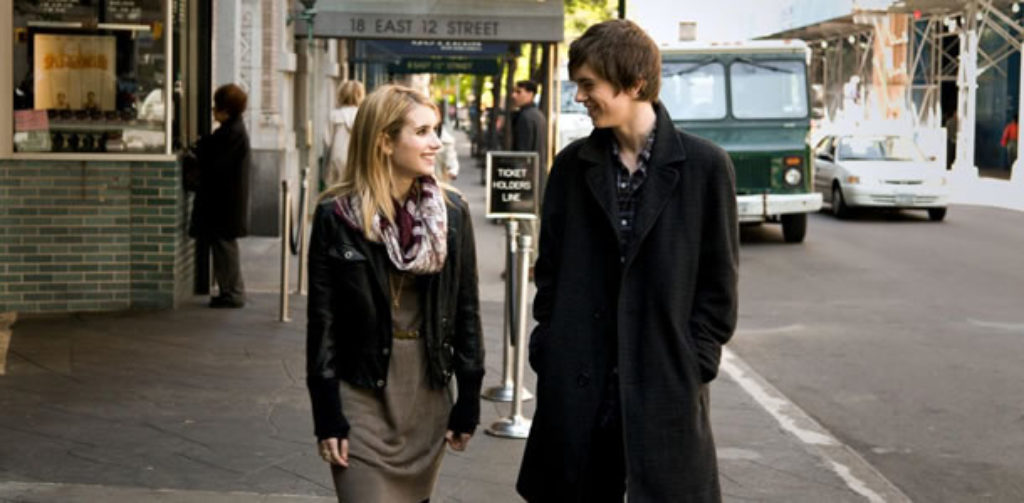
George is in something of a self-made funk. Listless and depressed enough to be totally focused on the fact that he’s going to die someday, he’s a slouch-around Manhattan prep schooler who cuts class to watch Louis Malle films at the local art house. That means he’s quasi-intellectual and young enough to think that just giving up makes as much sense as anything else.
And so for most of his senior year George has been checked out, tossing classwork aside on a growing pile of “who cares?” He draws ceaselessly—covering every square inch of his textbooks’ innards with a rambling pencil line of cartoons and fevered sketches—but even in art class he can’t seem to find anything worth saying. He simply drifts … an expressionless mop-haired cipher wrapped in a T-shirt and trench coat.
George’s well-meaning school principal and teachers want to give him a chance. But it’s so late in the year. Graduating is probably impossible. And his mom is caught up in so much of her own financial and relational woes that she can only fret in George’s direction and leave him be.
Then along comes Sally.
A pretty but equally bland young girl, Sally has her own weighty albatross of family dysfunctions and life dissatisfactions to deal with. So the two strike up a friendship. It’s a nodding understanding that leads to shared noodles on a city street walk and emo rock-underscored glances.
What else can this be but a love story?
George doesn’t have very many adults in his life who truly care about his welfare. But his school principal and his teachers come as close as anyone. Seeing George come through on an offered second chance, Principal Martinson tells the boy, “Anything is possible.”
It’s obvious that George’s mom loves him. But because of her own worries and a lack of will to correct her son, she is a totally ineffective parent. Still, after one big implosion at home, George hugs his weeping mom and dedicates himself to “turn[ing] things around.”
George meets a twentysomething artist named Dustin who encourages him in his art.
George draws a picture of a demon-like character with horns.
After bringing a drunken George back home to her room, we watch from behind as Sally strips off her dress. George spends the night on Sally’s floor and wakes to catch her smirking at his erection (a bump under the blanket). Sally asks George to have sex with her. But it’s an awkward moment that crumbles into embarrassment. It is implied that Sally has a sexual fling with Dustin, though. (We see her in a tank top in Dustin’s bed.) George and Sally kiss several times, as do Sally and Dustin. Dustin suggests that George “slam Sally up against a wall and start kissing her” if he wants to know how she feels.
Sally’s single mom (looking barely older than her) spends most of her screen time in a low-cut slip—between one sexual pickup or another. She openly talks with George and Sally about her escapades. And she suggests that George is probably a good lover because he’s ticklish. George is impressed with her and says, “My god, she’s amazing.” To which Sally retorts, “Not if you’re her daughter.” Sally later tells George that her last stepdad cheated on her mom “all the time.”
At a dance club George’s friend Zoe offers to hook him up with one of her “slutty friends.” Girls there wear formfitting and low-cut outfits. Upon seeing Sally dressed in a slinky dress George says, “I’m allergic to hormones … my own.” A guy at a club hits on Sally, grinding up close to her. George uses vulgar group-sex slang to describe a Valentine’s dinner.
George gets into a tussle with his stepdad. The two flail around and then slam into a wall, breaking the older man’s collarbone.
One f-word and a half-dozen s-words join two or three each of “h‑‑‑” and “b‑‑ch.” Jesus’ name is misused a handful of times.
Even though the central characters are high school kids, they and their friends all smoke and drink constantly at private and public parties and clubs. In numerous scenes we see George, Sally and others chug back everything from bottles of beer to shots of hard liquor.
While they chat, Sally’s mom drinks wine, and George and Sally have mugs of beer. After George wakes up with a hangover, Sally’s mom gives him tomato juice spiked with more alcohol.
Dustin stubs out a cigarette on his painting as a sort of finishing touch.
Drunk, George vomits on the sidewalk and then passes out. Both Sally’s and George’s mothers have been divorced and are currently either divorcing again or in the process of finding another, at least temporary, mate. George’s stepdad has little else to say to him than, “You’re pathetic.” George and Sally cut school.
The Art of Getting By just wants to, well, just get by. It is something of a poetic exposé on our modern youth culture and its angst-filled view of life. And in a very low-key way its characters do seek some kind of inspiration.
Any kind of inspiration.
Their pursuits, however, are so boozy, underplayed and passionless it’s really very hard to watch and care. In fact, if this superficially slick and generally depressing film were a TV show, most non-self-flagellating viewers would likely change the channel several minutes in. If you did choose to stick it out, you’d find that the real lessons it imparts have much more to do with the adults in the wings than the teens in the spotlight.
Even a small amount of understanding about life makes it pretty easy to connect the kids’ fatalistic views and general fecklessness with the self-absorbed adults in their lives at home. These moms—and whoever’s currently sitting in for dads—are so busy lying, bailing on commitments, traveling the world or rekindling their sexual wild sides that it would almost be unimaginable for their kids to not be rudderless.
From the moviemakers’ perspective, that may be an accidental takeaway. But it’s the one thing that rings true in a film that otherwise feels empty and hollow.


After spending more than two decades touring, directing, writing and producing for Christian theater and radio (most recently for Adventures in Odyssey, which he still contributes to), Bob joined the Plugged In staff to help us focus more heavily on video games. He is also one of our primary movie reviewers.
Our weekly newsletter will keep you in the loop on the biggest things happening in entertainment and technology. Sign up today, and we’ll send you a chapter from the new Plugged In book, Becoming a Screen-Savvy Family, that focuses on how to implement a “screentime reset” in your family!